This blog article was originally published on December 17, 2020, and was previously updated on December 11, 2022.
In the news: According to the National Weather Service, Sub-freezing temperatures will reach as far south as central Texas and northern Florida while sub-zero temperatures will be found across the upper Midwest. Multiple frontal systems arriving from the Pacific will bring heavy rain across California. Heavy, wet snow is expected in the Sierra Nevada. Freezing rain and sleet will impact Oklahoma and Kansas, spreading into the Midwest and followed by wet snow across the upper Midwest and into the Great Lakes.
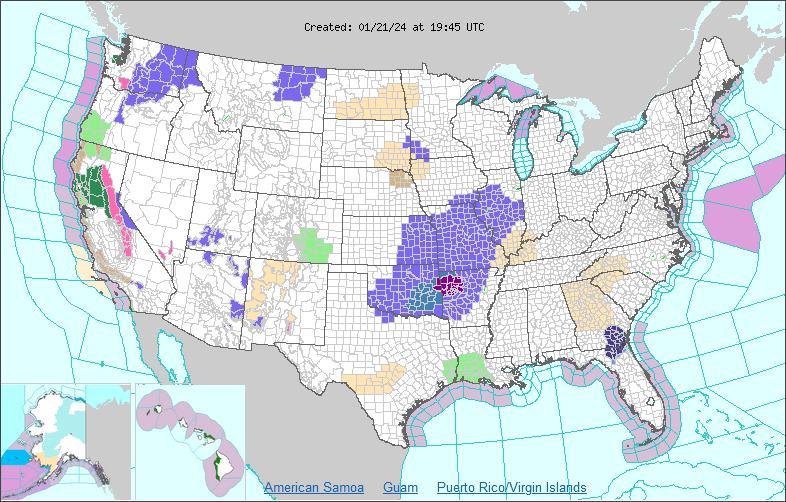
Make a weather map
ArcGIS Living Atlas of the World includes authoritative live feeds and other content that helps you learn more about current and predicted weather conditions. In this tutorial we will:
- Add weather and storm layers from Living Atlas.
- Make changes to layer visibility to display or hide layers.
- Use filters to further focus the scope of our weather map.
- Improve the map using transparency and other effects.
Follow these steps to make your own weather map in a minute, maybe less.
Step 1 — Sign in to your ArcGIS account and open Map Viewer. There are two ways to add layers from the Content (dark) toolbar:
(1) Click Add, then Browse layers.
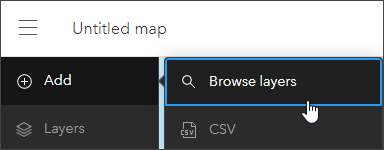
(2) Click Layers, then Add.
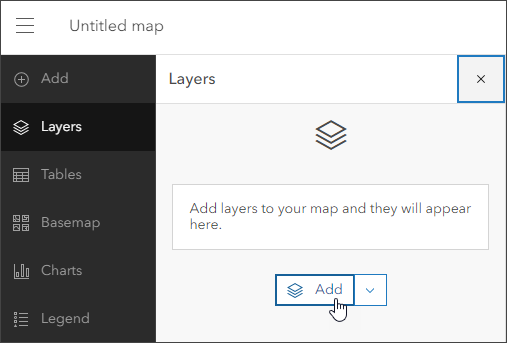
Step 2 — Choose Living Atlas from the Add layer drop-down.
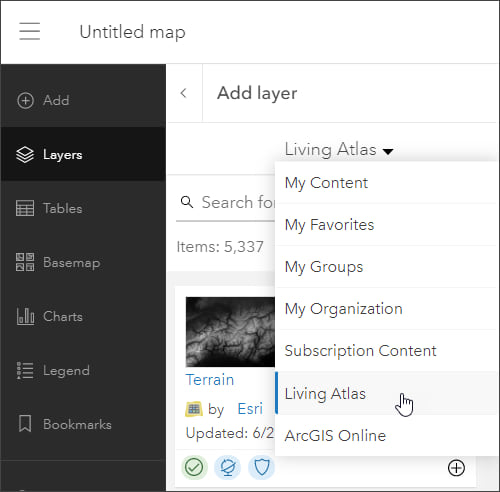
Step 3 — Enter “weather” in search to locate the USA Weather Watches and Warnings layer. Click [+ Add] to add it to the map.
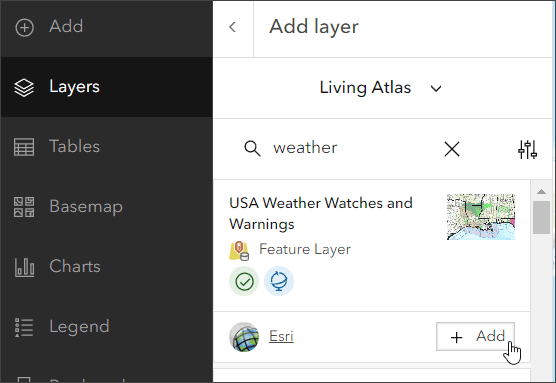
Step 4 — View the layer information to learn more.
Click the layer card to view the item information pane, providing quick access to the overview, description, details, and more.
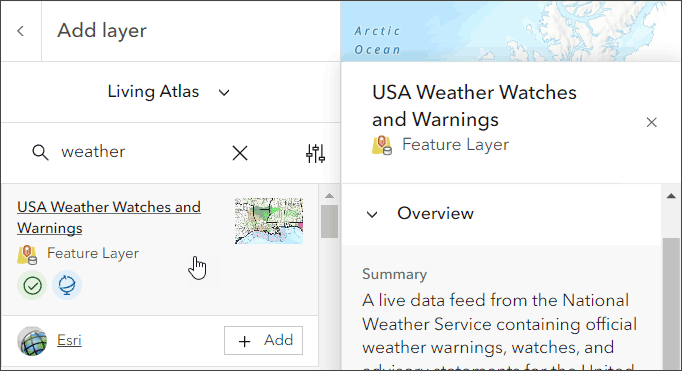
To open the full item pages, click View item details at the bottom of the pane

Looking at the USA Weather Watches and Warnings details, you can learn that the layer is a live data feed from the National Weather Service containing official weather warnings, watches, and advisory statements for the United States. The layer is updated every five minutes using the Aggregated Live Feeds methodology.
Step 5 — Click the left arrow to return to the Layers pane in the Contents (dark) toolbar.
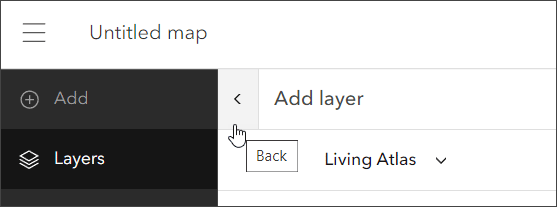
Step 7 — Click features on the map to view the layer pop-ups. Note that the layer is a group layer containing other layers.
When there are multiple features or layers found, you can cycle through the pop-ups using the arrows or feature pagination at the top of the pop-up pane. The USA Weather Watches and Warnings pop-up displays details such as the type of advisory, duration of the advisory, update date and time, and a summary with a link to more information.
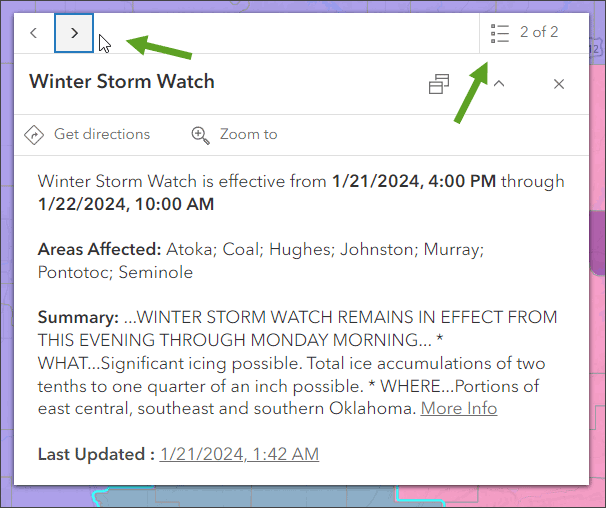
Congratulations! You’ve created a weather map in well under a minute.
In the next steps the layer visibility in the group layer will be changed to apply focus on specific information.
Step 8 — Expand the USA Weather Watches and Warnings group layer by clicking the arrow next to the layer name.

USA Weather Watches and Warnings is a group layer containing 11 layers, with four visible by default. In the Layers pane, you can toggle the visibility for layers or remove unwanted ones. For example, to display only watches and warnings you can hide the Public Forecast Zones, US States and Territories (most Living Atlas basemaps include state and territory boundaries), and Coastal and Offshore Marine Zones.
Hide the highlighted layers shown below.
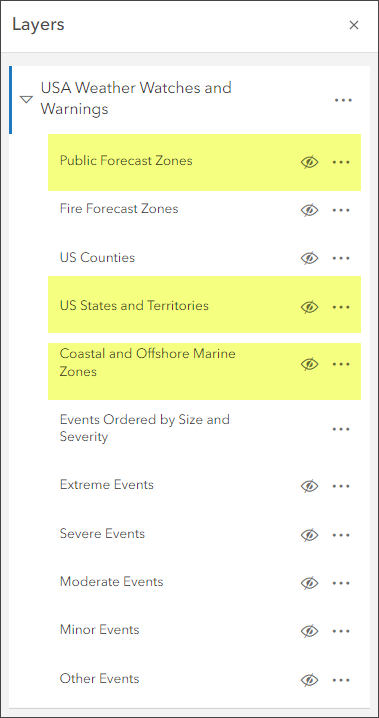
Below, the map on the left shows the default layer visibility. The map on the right hides the layers noted above.
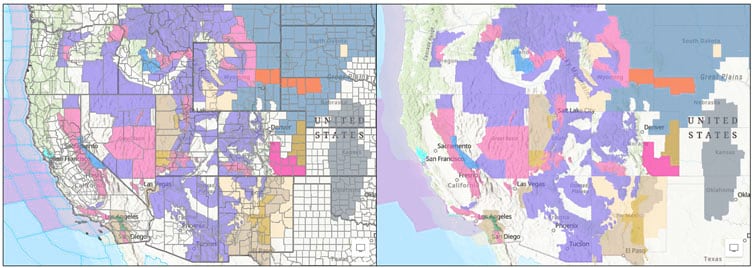
Apply layer filters
You can use layer filters to limit the visibility of certain features in the map, applying focus to what’s important to you.
Step 9 — View the National Weather Service watch/warning/advisory definitions. Decide which watch, warning, and advisory definitions you want to focus on. For this example, a filter will be created to focus on those that pertain to blizzards and winter weather.
Step 10 — In the Layers pane, select Events Ordered by Size and Severity. When a layer is selected, it is highlighted with a vertical blue bar.

Step 11 — Click Filter in the Settings (light) toolbar on the right, then click Add expression.
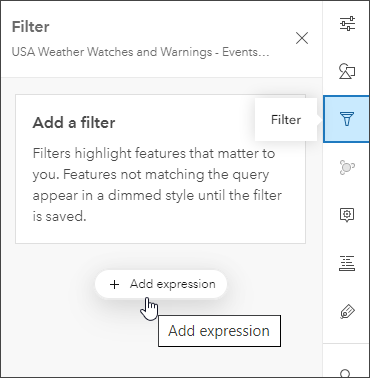
Step 12 — Construct a filter expression as follows:
a – Select Type as the attribute from the list.
b – Select includes as the operator from the dropdown list.
c – Choose the desired values from the dropdown list.
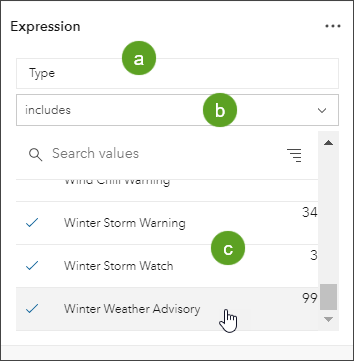
Tip: By default, attributes are listed by Count. Choose A to Z to make finding specific attributes easier.
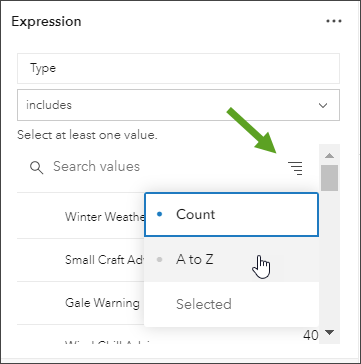
Step 13 — Click Save when finished.

The map shown below is the result of applying the following expression:
Type includes Winter Weather Advisory, Winter Storm Watch, Winter Storm Warning, Blizzard Warning, Blizzard Watch.
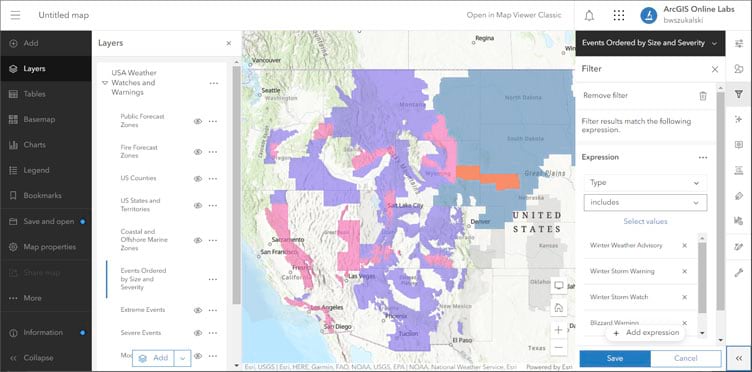
Improve the map
Experiment using different basemaps and layer settings until you get the desired result. For layers such as Weather Watches and Warnings that draw above underlying features, a basemap with reference layers that draw on top of the layer (such Terrain with Labels) is a good choice. You can also change the weather layer settings to achieve the desired results.
Step 14 — Change the basemap. Click the basemaps button in the Contents (dark) toolbar, and select Terrain with Labels.
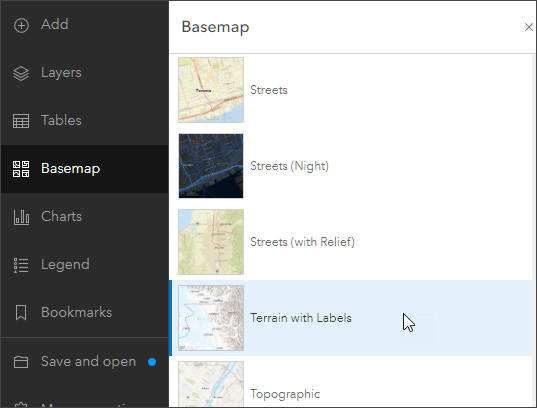
Terrain with Labels has reference layers which draw on top of all other layers. The basemap also has terrain which can be viewed below the weather events layer, which already has 40% transparency. In the next step, the layer will be adjusted to enable better terrain visualization.
Step 15 — Click Layers to open the Layers pane. Expand the group layers and select Events Ordered by Size and Severity.
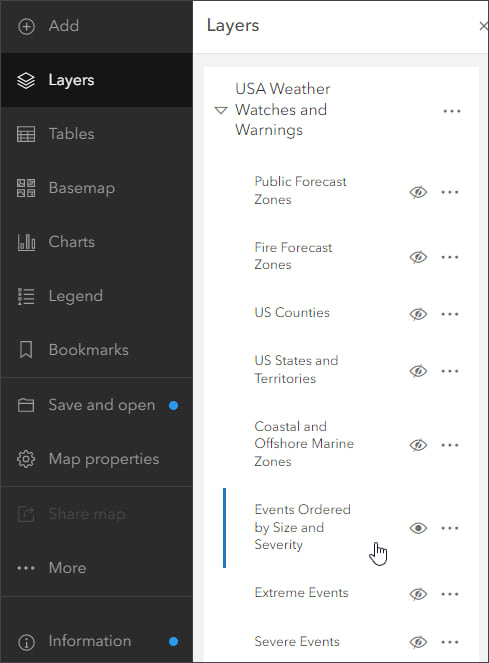
Step 16 — On the Settings (light) toolbar, click Properties and scroll down in the Properties pane to set transparency to 60%.
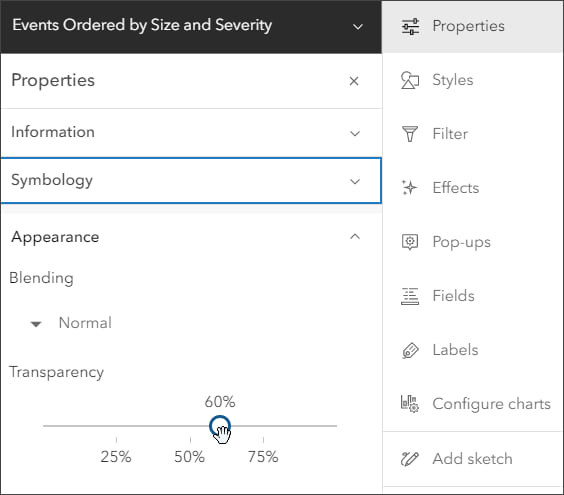
By setting the transparency, the layer saturation has also been reduced. Effects can be applied to increase the saturation, without affecting transparency.
Step 17 — On the Settings toolbar, click Effects. In the Whole layer effects enable Saturation and set the saturation strength to 150.
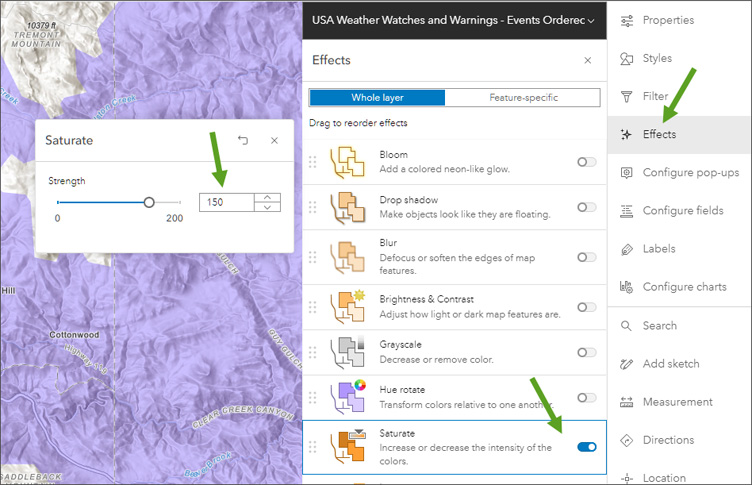
Step 18 — Blending can also be used to enhance the effects of layer transparency and saturation when viewed with the Terrain with Labels basemap. On the Settings toolbar, click Properties. Scroll down to find Blending in the Appearance section, and click the blending drop-down to select Multiply.
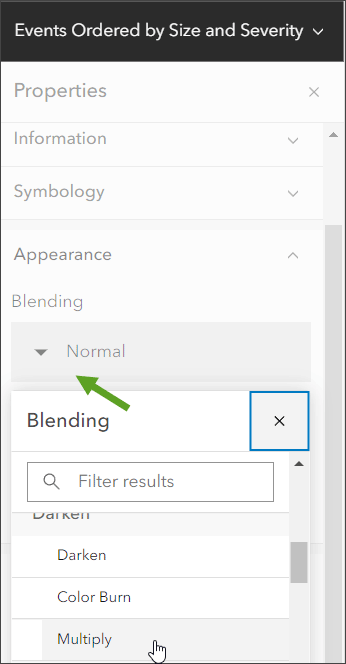
Step 19 — (Optional) You can also apply effects to basemap layers. Open the basemaps pane, open the World Hillshade basemap, then select the World Hillshade basemap layer. Open the Effects pane from the Settings (light) toolbar and adjust the brightness and contrast to dim the brightness.
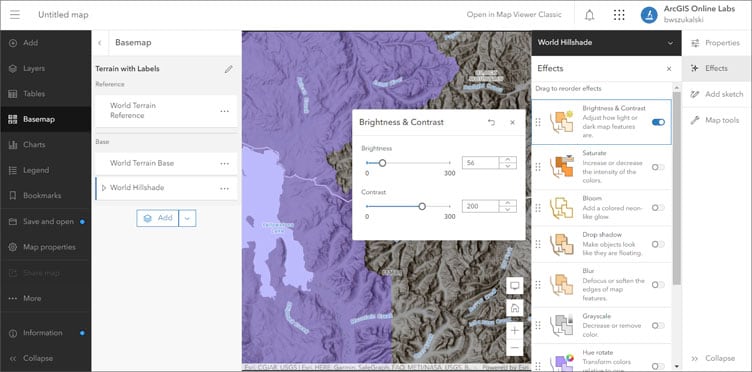
Step 20 — Experiment with the settings described above to achieve the desired results. When finished, Save your map.
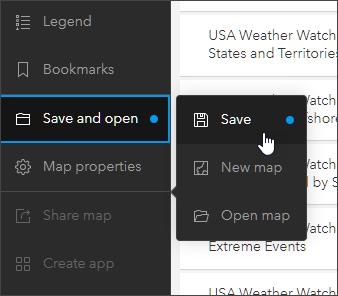
View the sample map authored in this tutorial.
More information
There are other weather related maps, apps, and layers you can explore. Browse Living Atlas to learn more.
For more information, see the following:

Commenting is not enabled for this article.